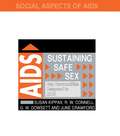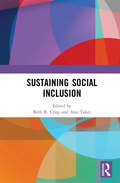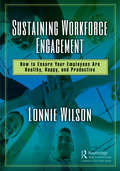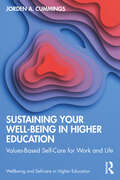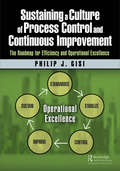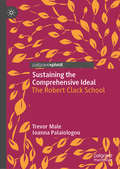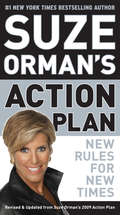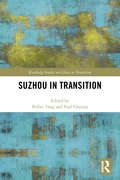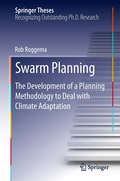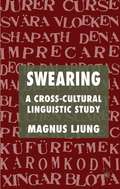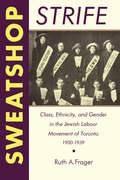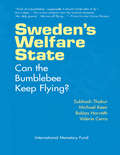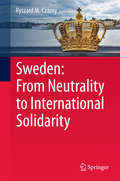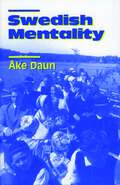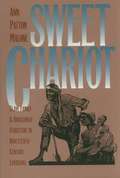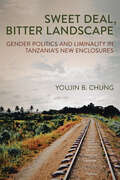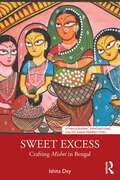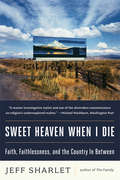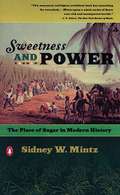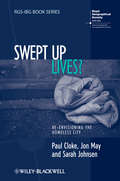- Table View
- List View
Sustaining Safe Sex: Gay Communities Respond to AIDS (Social Aspects of AIDS)
by R.W. Connell June Crawford G.W. Dowsett Susan KippaxThis book focuses on the cultural processes at work within the Australian gay communitites, which have made significant efforts at preventing the spread of the HIV virus. Sustaining Safe Sex has clear relevance to work throughout the world.
Sustaining Social Inclusion
by Beth R. Crisp Ann TaketSustaining Social Inclusion is the third book in a series on social exclusion and social inclusion. It explores what different understandings of sustainability mean in respect of social inclusion in the variety of fields that deal with human health and well-being. The book is global in its scope, with chapters relating to socially inclusive health and social welfare practice internationally. This book is divided into seven parts: Introduction; Sustainable policies for promoting social inclusion; Sustaining programmes which support social inclusion; Sustaining organisations which promote social inclusion; Sustainable social inclusion outcomes; Sustainable social development; and Conclusions. It examines how social inclusion can be sustained in the long-term when funding tends to be time-limited. This research-based book is relevant to a wide range of different readerships globally. It addresses issues of concern for those engaged in debates about the provision of health, social welfare, and other public services. Sustaining Social Inclusion will be of interest to academics, policy makers, and practitioners in a wide range of fields, including public health, health promotion, health sciences, history, medicine, philosophy, disability studies, social work, social policy, sociology, and urban planning.
Sustaining Workforce Engagement: How to Ensure Your Employees Are Healthy, Happy, and Productive
by Lonnie WilsonThis book explains the importance of employee engagement – It defines what it is, what it will do for your business, and how you can achieve it as well as sustain it. It covers the history of employee engagement along with why employees were formerly much more engaged with their work and company than they are currently. The author explains, in depth, why employees want to be engaged but are not. He discusses the emotional, psychological and social forces that make engagement, the state that people naturally and continually attempt to achieve. Furthermore, he makes a compelling case that engagement is not only natural, but, when achieved, it also creates a happy and productive workforce where employees are not only emotionally but also physically more healthy. You will learn exactly how a business can not only cause this engagement to surface, but also how to sustain it. He presents a complete discussion of the "basics and beyond" that are required to support a system of engagement. He explains engagement as a system and how to interpret and utilize a system diagram using the "high leverage points" to further fuel and sustain engagement. The book then provides a critical and comprehensive series of discussions of precisely what management must do to unlock the power of a fully engaged workforce. In addition to learning how to measure engagement, there are detailed discussions, along with two confirming case studies, of how to improve your levels of engagement. Essentially, the author examines engagement from top to bottom integrating the theories of the scholars, with the experiences of the practitioners. In so doing he can explain, in simple terms, how engagement can be achieved and why people try so hard to create a fully engaged workforce with both the best of intentions and a true passion to achieve it … yet fall short. There is a simple reason -- achieving engagement is all about management and the many changes that must be made, and that raises the crucial question: Is management both willing and able to recognize, accept, and execute the needed paradigm shifts? The stark reality is that the changes that must first occur are in the thoughts, beliefs, and actions of the management team. This book gives you a path to follow that may achieve just that. And the remaining question for the senior management is: What are you prepared to do? The mystery of achieving engagement is known, the science is known, the answers are not technically complicated, and now it comes down to a simple choice: Are you or are you not willing to change? And with that choice, there are resultant consequences. It is no more complicated than that.
Sustaining Your Well-Being in Higher Education: Values-Based Self-Care for Work and Life (Wellbeing and Self-care in Higher Education)
by Jorden CummingsThis book provides an evidence-based approach to sustainable self-care, anchoring these strategies in individual academic workers’ core personal values. It teaches readers how to use their values to leverage self-care strategies into a workable, individualized, and effective map to wellness.Working in the demanding environment of higher education can leave little time for self-care, yet making space for wellness and self-care is essential to creating a creative and innovative environment for academic work. This book shows how to create and successfully implement realistic self-care plans. By identifying core values and using these to develop individualized self-care plans, Sustaining Your Well-Being in Higher Education pushes back against a one-size-fits-all approach while also discussing the role of self-care in academic labor activism and providing strategies for readers to become advocates for better self-care practices within their zones of influence.Designed to provide academic workers with the skills they need to develop workable and sustainable self-care plans, this book is an invaluable resource for students and professionals working in all areas of higher education.
Sustaining a Culture of Process Control and Continuous Improvement: The Roadmap for Efficiency and Operational Excellence
by Philip J. GisiThis comprehensive book presents a methodology for continuous process improvement in a structured, logical, and easily understandable framework based on industry accepted tools, techniques, and practices. It begins by explaining the conditions necessary for establishing a stable and capable process and the actions required to maintain process control, while setting the stage for sustainable efficiency improvements driven by waste elimination and process flow enhancement. This structured approach makes a clear connection between the need for a quality process to serve as the foundation for incremental efficiency improvements. This book moves beyond talking about the value contribution of tools and techniques for process control and continuous improvement by focusing on the daily work routines necessary to maintain and sustain these activities as part of a lean process and management mindset. Part 1 discusses process quality improvement with an understanding of variation and its impact on process performance. It continues by stressing the importance of standardizing a process to achieve process stability. Once process stability is reflected in a consistent and predictable output, attention is turned to ensuring the process is capable of consistently meeting customer requirements. This series of activities sets the foundation for process control and the sustainable pursuit of efficiency improvements. Part 2 focuses on efficiency improvement by eliminating waste while improving process flow using proven tools and methods. Although there is a clear relationship between waste elimination and process flow, these activities are discussed separately to allow those more interested in waste elimination to work independently from those looking to optimize value stream flow. Part 3 explores the principles, practices, systems, and behaviors required to maintain process control while creating a mindset of continuous incremental improvement. It considers the role organizational structure, discipline, and accountability play as essential components for long term operational success. This book will: Provide readers with a clear roadmap for establishing, achieving, and maintaining process control as the foundation upon which to pursue efficiency improvements. Establish direction and methods for continuous and sustainable process improvement Define the practices, systems, and behaviors required to realize desired results and develop a culture of process control and continuous improvement along the road to operational excellence.
Sustaining the Comprehensive Ideal: The Robert Clack School
by Ioanna Palaiologou Trevor MaleThis book explores the development of educational leadership within difficult contexts via the lens of a previously failing English secondary school in an area of urban poverty. Based on extensive interview data from 2012-2016, the authors demonstrate that the fundamental ethos underpinning the school’s improvement is a desire to meet the needs of young people in disadvantaged communities in order to equip them with the skills to allow them to transcend their situation. The authors posit that this school embodies the ‘comprehensive ideal’ of secondary education in England: that education should not be disadvantaged by background, and that the state should provide free and high quality education for all. This book will appeal to students and scholars of comprehensive education and schools in difficult contexts.
Suze Orman’s Action Plan: Revised and updated from Suze Orman’s 2009 Action Plan
by Suze OrmanTimes have changed and the rules have changed, but financial security is still the goal. Do you know how to get there? There is a new reality out there--a new normal. What was once certain--that you would be able to retire comfortably, that you would pay for your kids' education, that your home would appreciate in value--is no longer a sure thing. So much has changed on the financial landscape that it's hard to know which moves are the right ones to make. Suze Orman's million-copy bestselling financial action plan--fully revised and updated for 2010 and beyond--will show you the way. NEW TIMES CALL FOR NEW RULES--AND THIS IS WHAT SUZE ORMAN'S ACTION PLAN DELIVERS: * up-to-date information on new legislation that could affect how you will achieve your financial goals* an explanation of new FICO practices, and a new strategy for dealing with credit card debt* sound advice about rebuidling your retirement plan, and what to do if you're already retired* guidance on how to live within your means, and strategies to keep you on the path to achieving your goals in this new age of financial honesty PLUS AN ALL-NEW CHAPTER ON KIDS AND MONEY--how to give your kids a solid financial education, no matter their age! Download Suze Orman's free Money Tool iPhone applicaton in the iTunes store.From the Paperback edition.
Suzhou in Transition (Routledge Studies on China in Transition)
by Beibei Tang Paul CheungThrough the lens of the city of Suzhou, this edited volume presents views on the complex interaction between the central state, market agents, local governments and individuals who have shaped the development of Chinese cities and urban life. Featuring a range of disciplinary perspectives, contributors to this volume have all undertaken research in one municipality – Suzhou— to consider how history and culture has evolved during the modernisation of Chinese cities and the transformation of urban space, as well as shifting rural-urban relations and urban life during the reform era. The volume is underscored by a complex dynamic system consisting of three-interlocked mechanisms through which the central and local state interact: history and culture, social and economic life, and administration and governance. As such, chapters analyse responses both from the state and society as driving forces of local development, with an interplay between tradition and heritage on the one hand and China’s economic and social development on the other. Suzhou in Transition will appeal to students and scholars of Chinese and urban studies, as well as urban sociology and geography.
Svalbard Imaginaries: The Making of an Arctic Archipelago (Arctic Encounters)
by Mathias Albert Lisbeth Iversen Dina Brode-RogerBy drawing on a broad range of disciplinary backgrounds, this book illustrates the immense complexities of Svalbard as a place, point of reference, or social concept. It portrays the multiple, situated perspectives that characterize understandings and imaginings of Svalbard, and brings together contributions from academic fields that rarely interact with each other.Svalbard Imaginaries contributes to a number of research contexts, ranging from a broadly conceived, multi-disciplinary field of ‘Arctic Studies’ to more disciplinary specific debates on how places are reworked at the interstices of various global flows and vice versa. It assembles contributions on imaginaries that cover a wide array of issues, including—but not limited to—Svalbard as a geopolitical site, a landscape, an image, a (mining) heritage assemblage, a tourist destination, a wilderness, a built environment, a site of knowledge production, a site of artistic engagement, and projections of the future. It deliberately assembles analyses that refer to a variety of timescales and covers representations of the past, the present, and possible futures of Svalbard.
Swarm Planning
by Rob RoggemaThis book shows that the problem of climate adaptation, which is described in social planning terms as 'wicked,' is at odds with the contemporary practice of spatial planning. The author proposes a new adjusted framework which is more adaptable to unpredictable, wicked, dynamic and non-linear processes. The inspiration for this new method is the behaviour of swarms: bees, ants, birds and fish are capable of self-organization, which enables the system to become less vulnerable to sudden environmental changes. The framework proposed in Swarm Planning consists of these four elements: Two levels of complexity, the first being the whole system and the second its individual components. Each of these has different attributes for adapting to change. Five layers, consisting of networks, focal points, unplanned space, natural resources and emerging occupation patterns. Each layer has its own spatial dynamic, and each is connected to a spatial scale. Non-linear processes, which emerge in different parts of the framework and include emerging patterns, connectedness and tipping points among others. Two planning processes; the first, 'from small to large' works upward from the slowest changing elements to more rapidly-changing ones. The second, 'on the list of partners' addresses each layer from networks through emerging occupation patterns. Swarm Planning applies this framework to a series of pilot studies, and appraises its performance using criteria for an adaptive landscape. The results show that the use of the Swarm Planning Framework reduces the vulnerability of landscapes as well as the impact of climate hazards and disasters, improves response to unexpected hazards and contains adaptation strategies. "This book is a must for planners in government and the private sector as it outlines the concept, strategies and techniques for swarm planning. It is also an important guide for policymakers looking to engage communities in a dialogue about the adaptation planning process. " Professor John Martin, La Trobe University "The ultimate value of the book lies in encouraging the planning community to consider options that go far beyond those offered by business-as-usual planning methodologies developed for a set of operating conditions that are fast becoming obsolete. As such it makes an important and much needed contribution to the field. " Assistant Professor Dr. Chrisna du Plessis, University of Pretoria
Swearing
by Magnus LjungThis study provides a definition and a typology of swearing and compares its manifestations in English and 24 other languages. In addition the study traces the history of swearing from its first known appearance in Ancient Egypt to the present day.
Sweatshop Strife: Class, Ethnicity, and Gender in the Jewish Labour Movement of Toronto, 1900-1939
by Ruth FragerIn the first half of the twentieth century, many of Toronto's immigrant Jews eked out a living in the needle-trade sweatshops of Spadina Avenue. In response to their expliotation on the shop floor, immigrant Jewish garment workers built one of the most advanced sections of the Canadian and American labour movements. Much more than a collective bargaining agency, Toronto's Jewish labour movement had a distinctly socialist orientation and grew out of a vibrant Jewish working-class culture.Ruth Frager examines the development of this unique movement, its sources of strength, and its limitations, focusing particularly on the complex interplay of class, ethnic, and gender interests and identities in the history of the movement. She examines the relationships between Jewish workers and Jewish manufacturers as well as relations between Jewish and non-Jewish workers and male and female workers in the city's clothing industry.In its prime, Toronto's Jewish labour movement struggled not only to improve hard sweatshop condistions but also to bring about a fundamental socialist transformation. It was an uphill battle. Drastic economic downturns, hard employer offensives, and state repressions all worked against unionists' workplace demands. Ethnic, gender, and ideological divisions weakened the movement and were manipulated by employers and their allies.Drawing on her knowledge of Yiddish, Frager has been able to gain access to original records that shed new light on an important chapter in Canadian ethnic, labour, and women's history.
Sweden's Welfare State
by Subhash Thakur Michael Keen Balázs Horváth Valerie CerraThe Swedish Prime Minister, Gèran Persson, has used the analogy of a bumblebee to describe the success of the Swedish welfare state, saying "Think of a bumblebee. With its overly heavy body and little wings, supposedly it should not be able to fly, but it does. " Drawing on its continued surveillance of the economic policies of IMF member states, this book examines the Swedish model and considers both its achievements and the challenges facing it in the 21st century. It also seeks to draw lessons from the Swedish experience for other countries that face similar challenges from developments in globalisation and demographics.
Sweden: From Neutrality to International Solidarity
by Ryszard M. CzarnyThis book presents the legal and political factors determining international relations, including the processes of integration in all their complexity. The overall structure of the book, together with the composition of its separate chapters, allows for some general assumptions, identifying the main tendencies and placing them in a contemporary social context as well as establishing their relations with the practices of today. The content is a compendium of basic information and data related to the international processes which occur within specific formal, legal and political frames. The book is divided into five parts featuring not only deep historical context but most of all presenting current information and analyses of the last few years. Presented against the background and within the context of the Kingdom of Sweden’s political system and its international environment, the book brings into the foreground issues of particular importance for Sweden’s continuing European integration process and describes its response to the developments in the international situation.
Swedes in Canada
by Elinor BarrSince 1776, more than 100,000 Swedish-speaking immigrants have arrived in Canada from Sweden, Finland, Estonia, Ukraine, and the United States. Elinor Barr's Swedes in Canada is the definitive history of that immigrant experience. Active in almost every aspect of Canadian life, Swedish individuals and companies are responsible for the CN Tower, ships on the Great Lakes, and log buildings in Riding Mountain National Park. They have built railways and grain elevators all across the country, as well as churches and old folks' homes in their communities. At the national level, the introduction of cross-country skiing and the success of ParticipACTION can be attributed to Swedes.Despite this long list of accomplishments, Swedish ethnic consciousness in Canada has often been very low. Using extensive archival and demographic research, Barr explores both the impressive Swedish legacy in Canada and the reasons for their invisibility as an immigrant community.
Swedish Mentality
by Åke DaunIs there a distinctly Swedish national character? Are Swedes truly shy, unemotional, conflict-avoiding, melancholy, and dour? Swedish Mentality, the English translation of the hugely successful book published in Sweden in 1989, considers the reality behind the myth. The author, Åke Daun, is a respected ethnologist who is sometimes referred to as the "guru" of Swedish character. In recent years, it has become popular to discuss Swedishness and Swedish identity. The advent of the European Union and the increasing presence of immigrant refugees in Sweden have fueled public debate on the distinctiveness of Swedish culture. Daun, however, goes beyond stereotype, drawing upon statistics gathered over more than a decade of research. The result is an entertaining and engagingly written book. Throughout, Daun quotes from interviews with native Swedes and immigrants as well as from travel accounts, folklore, and proverbs. We learn why some Swedes might prefer to walk up a flight of stairs rather than share an elevator with a neighbor and why some gain satisfaction from walking alone in the woods or going fishing. Daun describes a range of factors influencing Swedish character, including population composition, rural background, and even climate. He recognizes behavioral variations related to gender, age, class, and region, and he considers subtleties of individual character as well.Swedish Mentality should interest a wide array of readers, whether of Swedish descent or not.
Sweet Burdens: Welfare and Communality among Russian Jews in Germany
by Sveta RobermanSweet Burdens presents a detailed ethnographic study of the lives of Russian-Jewish immigrants in Germany over the past twenty years. Focusing on the first generation of adult immigrants, Sveta Roberman examines how they question and negotiate their moral economy and civic culture vis-à-vis the host German state and society, on the one hand, and the Holocaust past, on the other. She approaches the immigrant-host encounter as one of many cycles of social exchanges taking place in multiple and diverse arenas. The book sheds light on a number of issues, including the moral economy of Jewish-German relations, immigrants' performances of civics and citizenship, modes of inclusion and exclusion, consumption and consumerism, work and the phenomena of unemployment and underemployment, the concept of community, and the dynamics and difficulties of reinventing Jewish identity and tradition.
Sweet Chariot
by Ann Patton MaloneSweet Chariot is a pathbreaking analysis of slave families and household composition in the nineteenth-century South. Ann Malone presents a carefully drawn picture of the ways in which slaves were constituted into families and households within a community and shows how and why that organization changed through the years. Her book, based on massive research, is both a statistical study over time of 155 slave communities in twenty-six Louisiana parishes and a descriptive study of three plantations: Oakland, Petite Anse, and Tiger Island.Malone first provides a regional analysis of family, household, and community organization. Then, drawing on qualitative sources, she discusses patterns in slave family household organization, identifying the most significant ones as well as those that consistantly acted as indicators of change. Malone shows that slave community organization strongly reflected where each community was in its own developmental cycle, which in turn was influenced by myriad factors, ranging from impersonal economic conditions to the arbitrary decisions of individual owners. She also projects a statistical model that can be used for comparisons with other populations. The two persistent themes that Malone uncovers are the mutability and yet the constancy of Louisiana slave household organization. She shows that the slave family and its extensions, the slave household and community, were far more diverse and adaptable than previously believed. The real strength of the slave comunity was its multiplicity of forms, its tolerance for a variety of domestic units and its adaptability. She finds, for example, that the preferred family form consisted of two parents and children but that all types of families and households were accepted as functioning and contributing members of the slave community."Louisiana slaves had a well-defined and collective vision of the structure that would serve them best and an iron determination to attain it, " Malone observes. "But along with this constancy in vision and perseverance was flexibility. Slave domestic forms in Louisiana bent like willows in the wind to keep from shattering. The suppleness of their forms prevented domestic chaos and enabled most slave communities to recover from even serious crises."
Sweet Charity?: Emergency Food and the End of Entitlement
by Janet PoppendieckIn this era of eroding commitment to government sponsored welfare programs, voluntarism and private charity have become the popular, optimistic solutions to poverty and hunger. The resurgence of charity has to be a good thing, doesn't it? No, says sociologist Janet Poppendieck, not when stopgap charitable efforts replace consistent public policy, and poverty continues to grow. In Sweet Charity?, Poppendieck travels the country to work in soup kitchens and "gleaning" centers, reporting from the frontlines of America's hunger relief programs to assess the effectiveness of these homegrown efforts. We hear from the "clients" who receive meals too small to feed their families; from the enthusiastic volunteers; and from the directors, who wonder if their "successful" programs are in some way perpetuating the problem they are struggling to solve. Hailed as the most significant book on hunger to appear in decades, Sweet Charity? shows how the drive to end poverty has taken a wrong turn with thousands of well-meaning volunteers on board.
Sweet Deal, Bitter Landscape: Gender Politics and Liminality in Tanzania's New Enclosures (Cornell Series on Land: New Perspectives on Territory, Development, and Environment)
by Youjin B. ChungSweet Deal, Bitter Landscape brings us to the mid-2000s, when the Tanzanian government struck a deal with a foreign investor to convert more than 20,000 hectares of long-settled coastal land to establish a sugarcane plantation. Ten years on, the deal was abruptly abandoned. Popularly deemed a case of hubristic global development, critics classified this project another in a line of failed modern resource grabs. Youjin B. Chung argues such tidy accounts conceal myriad and profound implications: not only how gender, history, and culture shaped the project's trajectory, but also how, even in its stalled state, the deal upended social life on the land by setting in motion incomplete processes of development and dispossession. With rich ethnographic detail and visual storytelling, Sweet Deal, Bitter Landscape traces the lived experiences of diverse rural women and men as they struggled for survival under a seemingly endless condition of liminality. In so doing, she raises critical questions about the directions and stakes of postcolonial development and nation-building in Tanzania, and the shifting meanings of identity and belonging for those on the margins of capitalist agrarian transformation.
Sweet Excess: Crafting Mishti in Bengal (Ethnographic Innovations, South Asian Perspectives)
by Ishita DeyThis book is an ethnographic work on excess. Based on a decade-long field work of a single food substance — sweets — it follows sweet-making in sweetshops, domestic spaces, fairs, festivals and its representation in recipe books to understand how caste, religion, science and law inform the life of a food item with an extremely short shelf life. It shows how food items of conspicuous consumption find a meaning in everyday lives of people through its socio-cultural meanings - ritual, pride of craftsmanship, heritage and cultural identity. It also shows how sweets continue to be a ubiquitous part of ‘Bengali’ diet in a geography that has been witness to acute hunger, starvation, food movements and social welfare programmes to ensure food security.As a multi-sited ethnography on sweetness in diverse settings and its associated meanings in West Bengal and Bangladesh, this book explores everyday workplace hierarchies between artisans that reveal how caste and religion inform the choice of who is hired into this line of work. It also highlights how discourses on food safety and the overpowering presence of World Trade Organization have affected the life of the Bengali mishti.The volume will be of great interest to scholars and researchers of ethnography, sociology, history, and South Asian studies. And if you, dear reader, love mishti, you will love this, too!
Sweet Heaven When I Die: Faith, Faithlessness, and the Country In Between
by Jeff Sharlet"A master investigative stylist and one of the shrewdest commentators on religion's underexplored realms."--Michael Washburn, Washington Post In this gorgeous collection of essays that has drawn comparisons to the work of Joan Didion, John McPhee, and Norman Mailer, best-selling author Jeff Sharlet reports back from the far reaches of belief, whether in the clear mountain air of "Sweet Fuck All, Colorado" or in a midnight congregation of anarchists celebrating a victory over police. Like movements in a complex piece of music, Sharlet's dispatches vibrate with all the madness and beauty, the melancholy and aspirations for transcendence, of American life.
Sweet Spots: In-Between Spaces in New Orleans
by Teresa A. Toulouse and Barbara C. EwellContributions by Carrie Bernhard, Scott Bernhard, Marilyn R. Brown, Richard Campanella, John P. Clark, Joel Dinerstein, Pableaux Johnson, John P. Klingman, Angel Adams Parham, Bruce Boyd Raeburn, Ruth Salvaggio, Christopher Schaberg, Teresa A. Toulouse, and Beth WillingerMuch has been written about New Orleans's distinctive architecture and urban fabric, as well as the city's art, literature, and music. There is, however, little discussion connecting these features. Sweet Spots--a title drawn from jazz musicians' name for the space "in-between" performers and dancers where music best resonates--provides multiple connections between the city's spaces, its complex culture, and its future.Drawing on the late Tulane architect Malcolm Heard's ideas about "interstitial" spaces, this collection examines how a variety of literal and represented "in-between" spaces in New Orleans have addressed race, class, gender, community, and environment. As scholars of architecture, art, African American studies, English, history, jazz, philosophy, and sociology, the authors incorporate materials from architectural history and practice, literary texts, paintings, drawings, music, dance, and even statistical analyses. Interstitial space refers not only to functional elements inside and outside of many New Orleans houses--high ceilings, hidden staircases, galleries, and courtyards--but also to compelling spatial relations between the city's houses, streets, and neighborhoods.Rich with visual materials, Sweet Spots reveals the ways that diverse New Orleans spaces take on meanings and accrete stories that promote certain consequences both for those who live in them and for those who read such stories. The volume evokes, preserves, criticizes, and amends understanding of a powerful and often-missed feature of New Orleans's elusive reality.
Sweetness and Power: The Place of Sugar in Modern History
by Sidney W. MintzA fascinating persuasive history of how sugar has shaped the world, from European colonies to our modern dietsIn this eye-opening study, Sidney Mintz shows how Europeans and Americans transformed sugar from a rare foreign luxury to a commonplace necessity of modern life, and how it changed the history of capitalism and industry. He discusses the production and consumption of sugar, and reveals how closely interwoven are sugar's origins as a "slave" crop grown in Europe's tropical colonies with is use first as an extravagant luxury for the aristocracy, then as a staple of the diet of the new industrial proletariat. Finally, he considers how sugar has altered work patterns, eating habits, and our diet in modern times."Like sugar, Mintz is persuasive, and his detailed history is a real treat." -San Francisco Chronicle
Swept Up Lives?: Re-envisioning the Homeless City (Rgs-ibg Book Ser. #98)
by Paul Cloke Jon May Sarah JohnsenUtilizing innovative ethnographic research, Swept Up Lives? challenges conventional accounts of urban homelessness to trace the complex and varied attempts to care for homeless people Presents innovative ethnographic research which suggests an important shift in perspective in the analysis and understanding of urban homelessness Emphasizes the ethical and emotional geographies of care embodied and performed within homeless services spaces Suggests that different homelessness ‘scenes’ develop in different places due to varied historical, political, and cultural responses to the problems faced
